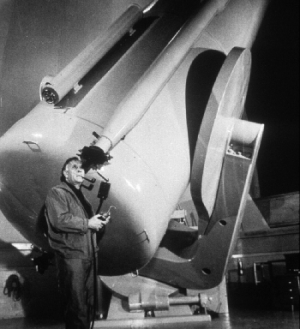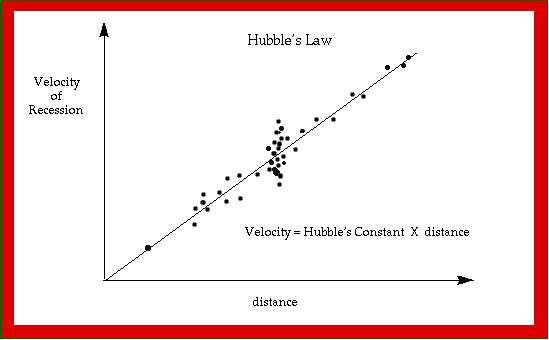|
|
More on Hubble's Law
 Looking at the skies from Mt. Palomar, Edwin Hubble in the 1920s found that
all far away objects (such as other galaxies) in the universe are moving
away from us, and that this motion, called their recession velocity, is
greater the further they are from us. In fact, he found the relationship
between a galaxy's velocity (the radial component, in a straight line)
away from us (v) and its distance from
us (d) approaches a fairly linear one, which is known as Hubble's Law:
Looking at the skies from Mt. Palomar, Edwin Hubble in the 1920s found that
all far away objects (such as other galaxies) in the universe are moving
away from us, and that this motion, called their recession velocity, is
greater the further they are from us. In fact, he found the relationship
between a galaxy's velocity (the radial component, in a straight line)
away from us (v) and its distance from
us (d) approaches a fairly linear one, which is known as Hubble's Law:
v = H0 x d
where H0 is an observationally determined constant (called
Hubble's constant). Finding the value of Hubble's constant is a current
hot topic in astronomy, and it has many implications for our understanding
of how the Universe evolved since the Big Bang.
How in the world (how in the Universe, rather!) did we come to know
about this phenomena? Well, figuring that out was the work of Vesto M.
Silpher and Edwin Hubble.
In 1912 American born astronomer Vesto M. Silpher discovered that the light
from all of the galaxies that he observed, regardless of the direction he
looked, appeared to be redshifted; they are moving away.

Vesto M. Silpher
|

Edwin
Hubble |
Edwin Hubble, utilizing observational data of distant galaxies, sought to
find a relationship between their distance from us and their speed. He
plotted recessional velocity determined by the doppler shift of stellar
spectra as a function distance and established what is now know as Hubble's
Law. Hubble's law applies to the objects in the Universe on the largest
scales, where the force driving their motions is the expansion of the
Universe.

Hubble's Law
So...., in theory, if you knew the distance to M31 and you knew Hubble's
constant (H0), you could use Hubble's Law to find the velocity
of M31!
|
